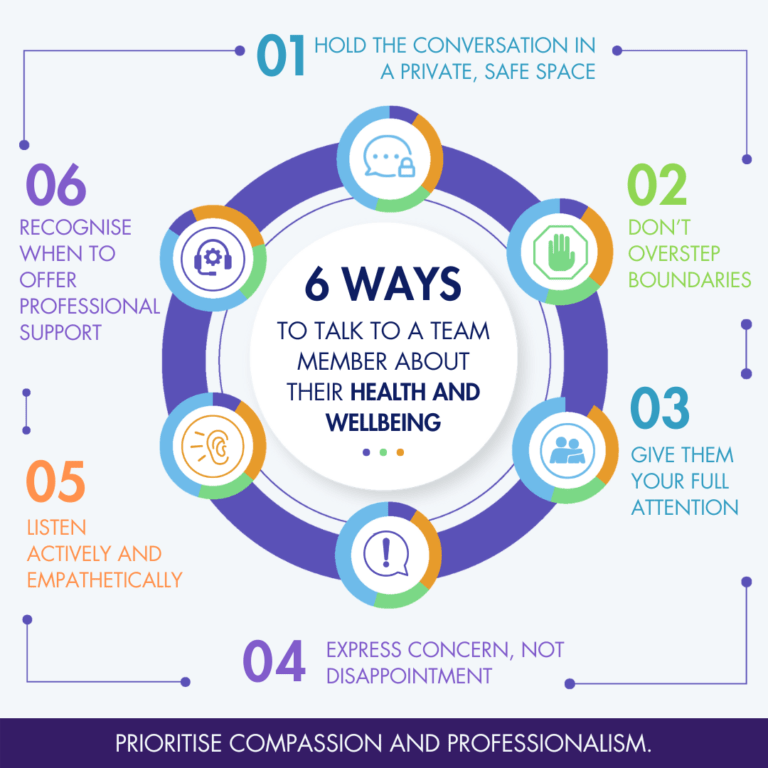Supporting and improving employee wellbeing is a continuous process. One of the best tools to help you do this? Line managers.
In addition to handling their many responsibilities in the workplace, line managers must also support their team members’ mental and physical health needs in order to create a thriving and productive working environment.
Wondering where to start? In this sixth instalment of our line management blog post series, we’re looking at how line managers can learn how to give their team members the best form of health and wellbeing support in the most sensitive, attentive way possible.
Our employee health and wellbeing support guidance follows a straight-forward, 4-Step Plan: recognising signs of poor health, holding open conversations with team members, making effective interventions, and referring to professional resources and experts. So, sit back and let’s explore some invaluable health management strategies you could start using today.
You’re reading a blog post from our Line Management series
Below are links to all the posts in this series:
Step 1: Learning to Recognise Signs of Poor Health
- Prevent any serious problems from festering or developing into potentially life-threatening or debilitating illnesses. By being encouraged to take health issues seriously, employees can safeguard their overall well-being and feel personally supported and cared for by their manager.
- Help employees feel supported on a professional level. When a line manager is aware of one of their team member’s health concerns, they can help them navigate these issues while avoiding unexplained absences and reduced performance levels.
- Increase employee satisfaction – if their line manager shows concern and a supportive attitude, team members will feel more valued as an integral part of the manager’s team.
- Build trust in the line manager as a reliable figure of support. In the long run, this will help create a stronger team dynamic.
When line managers take notice of their team members’ physical and mental wellbeing, they’ll be more likely to spot the following signs of poor health:
- Changes in mood: low energy or withdrawal from social activities and interaction.
- Changes in behaviour: developing an anxiety/stress-related tic, becoming aggressive, irritable, or quieter than usual.
- Changes in physical appearance: sudden weight gain/loss, sallow skin, or a limp.
- Changes in appetite: e.g., skipping lunch breaks or stopping eating in the staff room.
- Complaints of pain or discomfort.
- Changes in performance: inability to complete tasks they once managed without difficulty, increased mistakes, tardiness, or absenteeism.
Of course, these signs are not conclusive and can vary significantly according to the individual affected. However, such changes often point to an underlying physical or mental health issue/s. Therefore, it’s vital that line managers take notice of these signs and treat them seriously.
Illness-related absenteeism could seriously impede the success of your business. According to data from Public Health England, the annual economic cost of sickness absence is estimated to be over £100 billion! Taking care of your employees’ health can help you reduce these costs and create a healthier workplace where all can thrive.

Step 2: Conducting Candid Conversations about Health
After recognising signs of poor health in an employee, line managers might wonder, “What’s next?”. How on earth do you begin to tackle these kinds of issues with the utmost levels of tact and sensitivity?
Once you recognise the problem being experienced, gaining a deeper understanding of it is essential. To develop the best solution and support mechanisms, line managers must try to gain a fuller understanding of the team member’s health issues. The only way to do this is to have an open, candid, and honest conversation with the affected employee.
Navigating along the lines of professionalism, respect, and empathy can be a daunting challenge. However, by following our top 6 tips, line managers can conduct these conversations with care.
6 Ways to Talk to a Team Member about Their Health and Wellbeing
- Ensure Privacy: Any conversation about an employee’s health must be private and confidential. Line managers should schedule 1:1 sessions in safe spaces, e.g., a private office or a pre-booked meeting room. Alternatively, selecting a space outside of the office where traditional office hierarchies are not spatially enforced would be an excellent idea. You could speak about your concerns over a cup of tea in a local café or go for a walk to get some fresh air and chat things through away from the pressures of your workplace.
2. Don’t Overstep Boundaries: Line managers should never ambush their employees into revealing personal details about their mental or physical health. They must give them leeway to speak and reassure them that they only need to share what they are comfortable talking about. While the conversation should be informal, line managers must remember their professional responsibilities and not push for personal information.
3. Express Concern, Not Disappointment: Line managers could use specific phrases to verbalise their worries, e.g., “I’m checking in on you because I’m not sure you’ve seemed like yourself lately” or “I’m concerned about your wellbeing” to explain why they want to have this conversation. This discussion should never be about reprimanding a team member for ‘slacking off’ or failing to meet targets.
4. Stay Focused: It couldn’t be more important for line managers to provide their team members with their full attention during these types of conversations. They should switch off their email alerts and place their phones on silent to limit any distractions.
5. Actively Listen: Active listening = empathetic listening. Line managers should let their employees speak freely without interruption. This conversation should be about how their team member is feeling – it’s not a space for the line manager to dominate the conversation. They mustn’t adopt a hardline of inquiry but should instead allow the employee to steer the conversation in whatever direction they want to. Line managers could employ nonverbal cues like nodding to demonstrate active listening without interrupting. They could also issue small, supportive verbal reassurances whilst listening, e.g., “I understand”, “Please go on”, and “I’m listening”.
6. Recognise Limitations: Line managers are not usually trained health experts and should never try to answer medical questions with specific advice or diagnoses. Instead, they should acknowledge their team member’s medical concerns and questions but tell them they’re not in a position to diagnose them. They should always be honest and tell their employees when they don’t know the answer to a specific question (while working to gather more information about how they can best help them).
Step 3: Effective Health Interventions in the Workplace
Once aware of a team member’s struggles, line managers can intervene, providing individuals with effective health support. In their capacity as line managers, they can implement health-boosting strategies into their workplace to prevent team members from struggling with their physical or emotional well-being.

6 Effective Interventions for Supporting Employee Health and Wellbeing:
- Risk Assessments: Line managers should undertake risk assessments to gauge how safe their workplace environments and practices are for their employees. Thrive4Life’s sister company, Osteopaths for Industry, offers employers a Manual Handling Risk Assessment that (if relevant to your organisation) can help line managers improve physical health conditions in the workplace. At Thrive4Life, we also offer a 15-minute Employee Health Check that can help you and your employees keep track of fundamental health factors like blood sugar levels, BMI, and cholesterol.
2. Flexible Working Arrangements: Where possible, line managers should try to offer their team remote work options, longer breaks, and hybrid work arrangements. The extra time these arrangements can give employees can help them take care of their health by scheduling medical appointments, getting in some exercise, or having some downtime to relax and switch off from work. Line managers should also be flexible when setting targets and help struggling employees meet their KPIs by sharing out tasks and offering every team member reasonable deadlines that take into account their workload and professional/personal commitments.
3. Ergonomic Working Arrangements: Line managers should provide ergonomic working arrangements to ease any physical discomfort or strain employees may be struggling with. To do this, they can offer workstations with adjustable heights, footrests, and ergonomic computer equipment. These measures can all mitigate the risk (or lessen the discomfort) of individuals suffering from musculoskeletal issues. Line managers should also ensure their office space has adequate lighting, is toxin-free, and is accessible for wheelchair users.
4. Improving Nutrition: Line managers should take steps to look after their employees’ nutritional needs. According to research, we make around 200 food-related decisions every single day. However, these decisions are significantly affected by our physical environments. This means that if employees are surrounded by unhealthy foods in the office, this can trigger or exacerbate health issues like diabetes, obesity, or disordered eating. Line managers could arrange for healthy meals to be made available to their team members or provide vouchers for health food shops or cafés. Similarly, they should take stock of employees’ nutritional restrictions and communicate these to their company’s cafeteria, e.g., any allergies, halal/kosher requirements, vegan diets, gluten intolerances/coeliac disease, lactose intolerances, and individuals who eat a sugar-free diet.
5. Activity Plans: As office workers spend a large proportion of the working week sat at a desk in front of a computer, they run the risk of leading largely sedentary lifestyles. To combat this, line managers should organise activities that improve their team’s fitness levels and keep them physically active. Activities like runs, walks, or even group sports can provide physical stimulation and improve employees’ mental health by breaking the monotony of their office routine.
6. Encouraging Kindness and Positivity: Having kind, supportive colleagues can make all the difference to a person’s health. Line managers can create a friendly, kind, and psychologically safe workplace by organising team-building activities like office potlucks, ice-breaker sessions/games, and encouraging employees to share their hobbies and interests. Not only can this improve employee mental health, but learning to care for one another can help employees support each other’s physical health needs.
- Wellbeing Consultancy: At Thrive4Life, our highly experienced team offer wellbeing consultancy services that can assess your employees’ health needs, evaluate health risks in your workplace, and design a bespoke strategy that boosts your workplace wellbeing. Having a strategy to follow can help line managers better support individuals struggling with any aspect of their health or wellbeing.
- Mental Health First Aid Course: Thrive4Life’s Mental Health First Aid Course allows line managers to gain MHFA England accreditation as Mental Health First Aiders. The training and professional knowledge provided by this course will equip line managers to act as a source of first-line, in-house mental health support for their employees, giving them the tools to deal with crisis situations and everyday issues.
- Mental Health Skills Development: To further boost the knowledge and practical training provided by the MHFA accreditation, Thrive4Life offers a skills development course to help line managers refresh their mental health management skills and seek further organisation-specific advice from our team of licensed professionals.
- Employee Wellbeing Hub: There’s a maelstrom of health and wellbeing-related information out there, and it can be tricky to know which way to turn. That’s where we come in. With our Health and Wellbeing Discovery Hub, we can take the hassle out of your health and wellbeing provision.
The Hub is an easily-accessible health management tool, where you can access a personalised, ever-expanding library of written and video content on a range of physical and mental health issues. Having this e-learning healthcare database in your toolkit can take the pressure off line managers who’ll know that their team members have access to health and wellbeing materials whenever they need them most.
- Health and Wellbeing Newsletters: At Thrive4Life, you can also purchase access to our monthly health and wellbeing-related newsletter. This consists of two insightful and educational articles that aim to promote employee awareness about particular topics relating to the pillars of wellbeing. From articles on sleep to nutrition, common ailments, emotional wellbeing, and much more, our newsletters can help line managers and employers embed an organisation-wide ethos which sees the health of its employees as a top priority.
In Summary
When a team member is struggling, line managers need to know how they can help them feel happier and healthier. With the help of our 4-Step Plan, line managers can provide employees with the most comprehensive and effective physical and mental health support possible. Not only will this help them spot the signs of health issues amongst their team, but also hold compassionate conversations with them, adopt health and wellbeing-promoting strategies in the workplace, and consult the best professional resources for further support and guidance. Good physical and emotional health is the cornerstone of any successful organisation, and line managers are the key to creating a workplace culture that sees employee wellbeing at its heart. With Thrive4Life’s help, you can create a workplace where everyone feels supported, valued, and ready to do their job to the best of their ability.
References
1. Workplace Health: Applying Our Health. [2022]. Office for Health Improvement and Disparities.
https://www.gov.uk/government/publications/workplace-health-applying-all-our-health/workplace-health-applying-all-our-health#facts-about-workplace-health
2. Eight Tips When Talking About Employees About Their Personal Medical Needs. [2022]. MyHealthMath.
https://myhealthmath.com/2022/05/17/eight-tips-when-talking-with-employees-about-their-personal-medical-needs/
3. Manual Handling Risk Assessments. Osteopaths for Industry.
https://www.ofi.co.uk/manual-handling-training/manual-handling-risk-assessment/
4. Employee Health Checks. Thrive4Life.
https://www.ofi.co.uk/manual-handling-training/manual-handling-risk-assessment/
5. Behavioural Interventions to Improve Home-Based Office-Workers Health. [2022]. Trends in Psychology.
https://link.springer.com/article/10.1007/s43076-021-00122-x
6. Wellbeing Consultancy. Thrive4Life.
https://www.thrive4life.co.uk/wellbeing-consultancy/
7. Mental Health First Aider Course. Thrive4Life.
8. Mental Health Skills Development. Thrive4Life.
9. Employee Wellbeing Hub. Thrive4Life.
10. Health and Wellbeing Content. Thrive4Life.
https://www.thrive4life.co.uk/health-wellbeing-promotion/health-and-wellbeing-discovery-hub/
Please note, these are external links away from the Thrive4Life website. We are not responsible for the content of external websites.










